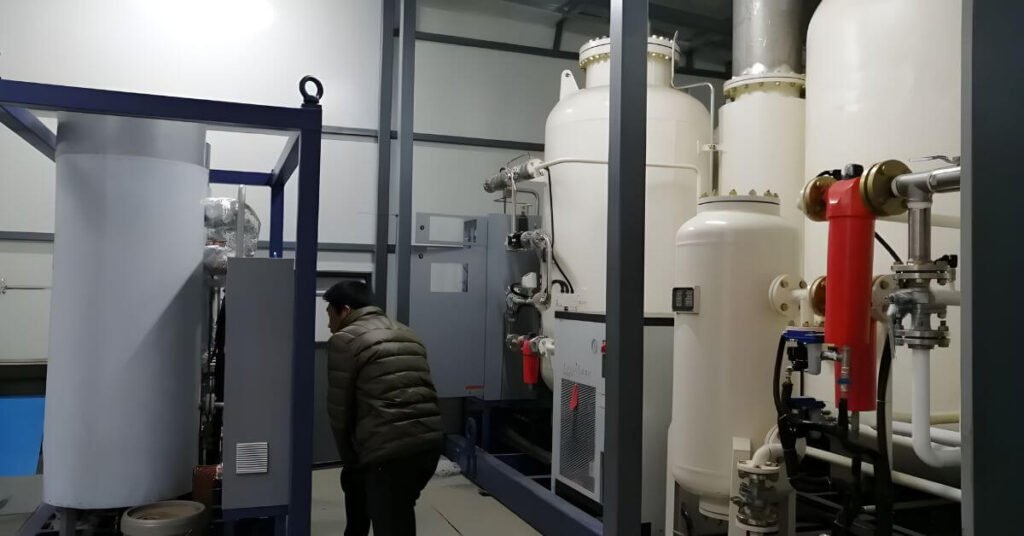PSA nitrogen generators are on-site nitrogen systems featuring low operating costs, fast nitrogen production, and easy maintenance. They play a critical role in modern industrial manufacturing processes. OxyNitra’s PSA nitrogen generators are widely used in industries like chemicals, oil and gas, electronics, food, mining, pharmaceuticals, cables, and metals.
Proper maintenance knowledge of nitrogen generators is essential. Good operating practices and regular upkeep can extend normal equipment lifespan, reduce energy consumption, lower maintenance costs, and effectively prevent sudden failures – greatly minimizing negative impacts on production.
Maintenance of pressure swing adsorption (PSA) nitrogen generators involves upkeep of air compressors, refrigerant dryers, and filters per technical requirements to ensure air quality (the air supply must be oil-free). Air compressors and refrigerant dryers should be serviced at least once a year, with replacement of wearing parts and maintenance according to equipment guidelines.
During operation, carbon molecular sieves have a certain amount of abrasion. The sieves should be inspected and refilled once a year.
Daily Maintenance of PSA Nitrogen Generators
Maintenance of the nitrogen system equipment mainly includes upkeep of air compressors, refrigerant dryers, filters, and the nitrogen generator unit.
Daily air compressor maintenance primarily involves regularly checking whether the drain valve and ventilation holes of the air tank are unobstructed. Heat exchangers on refrigerant dryers should be cleaned regularly. Drain valves on filters need to be checked frequently for clogs. Muffler exhaust ports on nitrogen generators also require checks for unobstructed flow.
All external components should be kept clean by regular wiping with a damp cloth or neutral soap and water.
Air Compressor Maintenance
- Keep the nitrogen generator clean.
- Open the water drain valve on the air tank daily to drain oil and water. In humid environments, open it every four hours.
- Check oil levels daily to ensure lubrication between compressors.
- Clean or replace air filters approximately every 150 days (filter elements are wearing parts). Frequency may be adjusted based on environment.
- Check belt tightness and screws on all components monthly.
- Change lubricating oil initially after 100 hours of operation, then every 1,000 hours (or every 500 hours in poor environments).
IMPORTANT: When changing the oil, the crankcase must be cleaned before adding new oil.
- Remove and clean the air valve every 1,000 operating hours (or every 6 months).
- Clean all parts of the machine annually.
Maintenance of High-Efficiency Oil Separators
- Manually drain the drain valve every 8 hours under normal conditions.
- Electronic drainers drain automatically every 8 hours – just check for clogs.
- Replace filter elements in oil separators about every 6,000 hours.
Maintenance of Precision Filters
- Manually drain the drain valve every 8 hours under normal conditions.
- Electronic drainers drain automatically every 8 hours – just check for clogs.
- Replace filter elements in precision filters about every 8,000 hours.
Maintenance of Refrigerant Dryers
- Manually drain the drain valve every 8 hours under normal conditions.
- Electronic drainers drain automatically every 8 hours – just check for clogs.
- Clean the fins on the air-cooled condenser once a week with blowing. Extend interval if less dusty.
Maintenance of PSA Nitrogen Generators
- Maintenance of pneumatic valves.
- Maintenance of adsorption towers.
- Replace oxygen sensor electrodes in nitrogen analyzers every 6 months.
Maintenance of Electrical Systems
- Regularly check all connections for detached wires or loose contacts, and promptly repair as needed (with power off).
- Frequently clear dust in electrical boxes (after disconnecting power) and inspect panel plugs, repairing as necessary.

